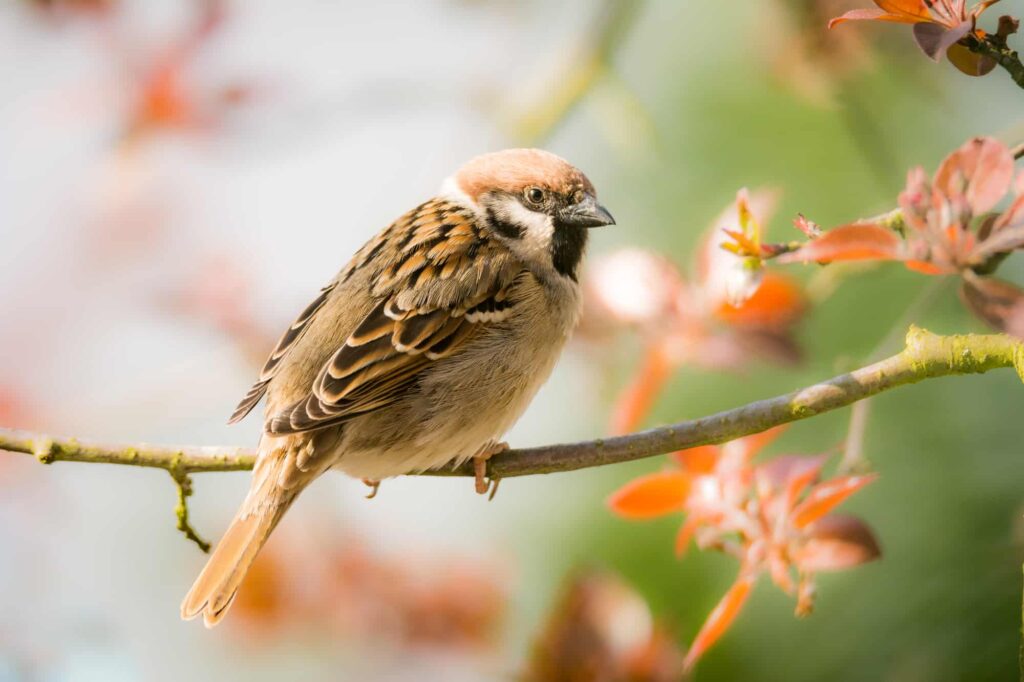Sparrows are some of the most commonly seen but most daunting birds to identify for many bird watchers.
While other backyard birds in Iowa like finches, cardinals, or jays have easily distinguishable colors and patterns, correctly identifying typically streaky brown sparrows can feel like a slightly more difficult task.
If you’re just getting started in the world of birding, don’t fear. While they may be small, sparrows do have their own unique and identifiable markings that can help you tell them apart.
Unless otherwise stated, all measurements are via the Cornell Lab of Ornithology’s All About Birds, a helpful guide to bird identification, habitat and behavior, and more.
So, grab your field guide and let’s get started – we’ll have you spotting sparrows by sight in no time!
23 Sparrows That Live in Iowa
House Sparrow
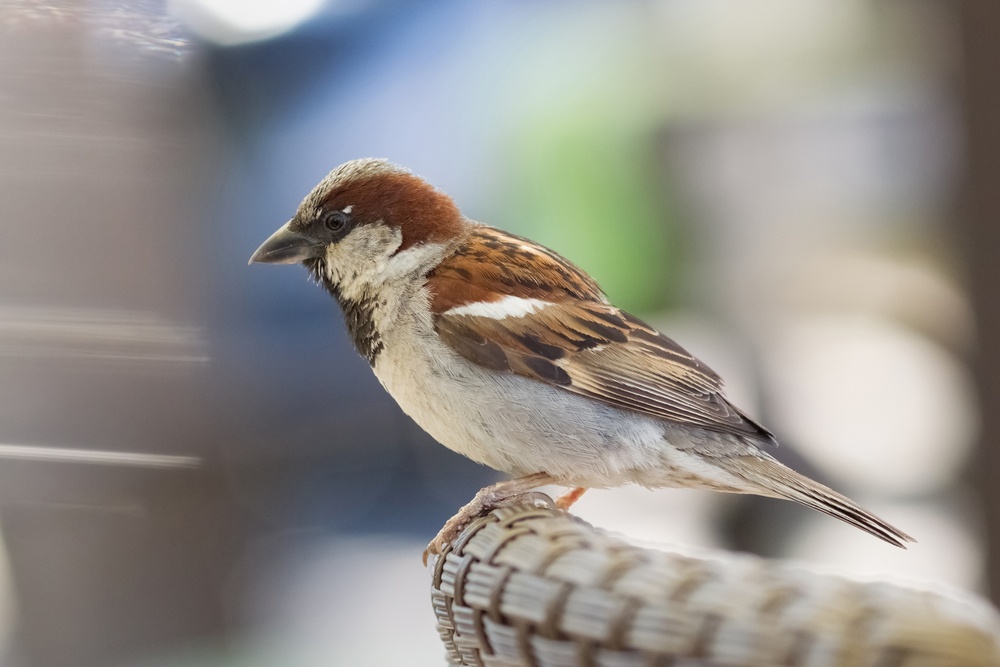
- Passer domesticus
- Length: 5.9-6.7 inches
- Weight: 0.9-1.1 ounces
- Wingspan: 7.5-9.8 inches
Our sparrow list begins with the house sparrow, one of the most common birds across the planet.
According to the Cornell Lab of Ornithology’s All About Birds, the house sparrow was introduced in New York in 1851. Since then, house sparrow populations have exploded across much of the continent.
They’re unpopular but common backyard birds, especially in suburbs and cities. A lot of that unpopularity stems from their reputation as bully birds.
House sparrows aren’t super closely related to any of the other sparrows on this list, and that plays out in their identification as well, as they have thick bodies and short, stocky bills.
Breeding males have unique markings over much of the body: they are black below the bill and around the eye, with a rich brown stretch on the side and back of the head. Their wings are a mix of brown and black that stands out against their light bottom side.
Females have the look of a typical sparrow, with light undersides and patterned brown wings. Their thick black bills can help you identify them, in part.
Eurasian Tree Sparrow
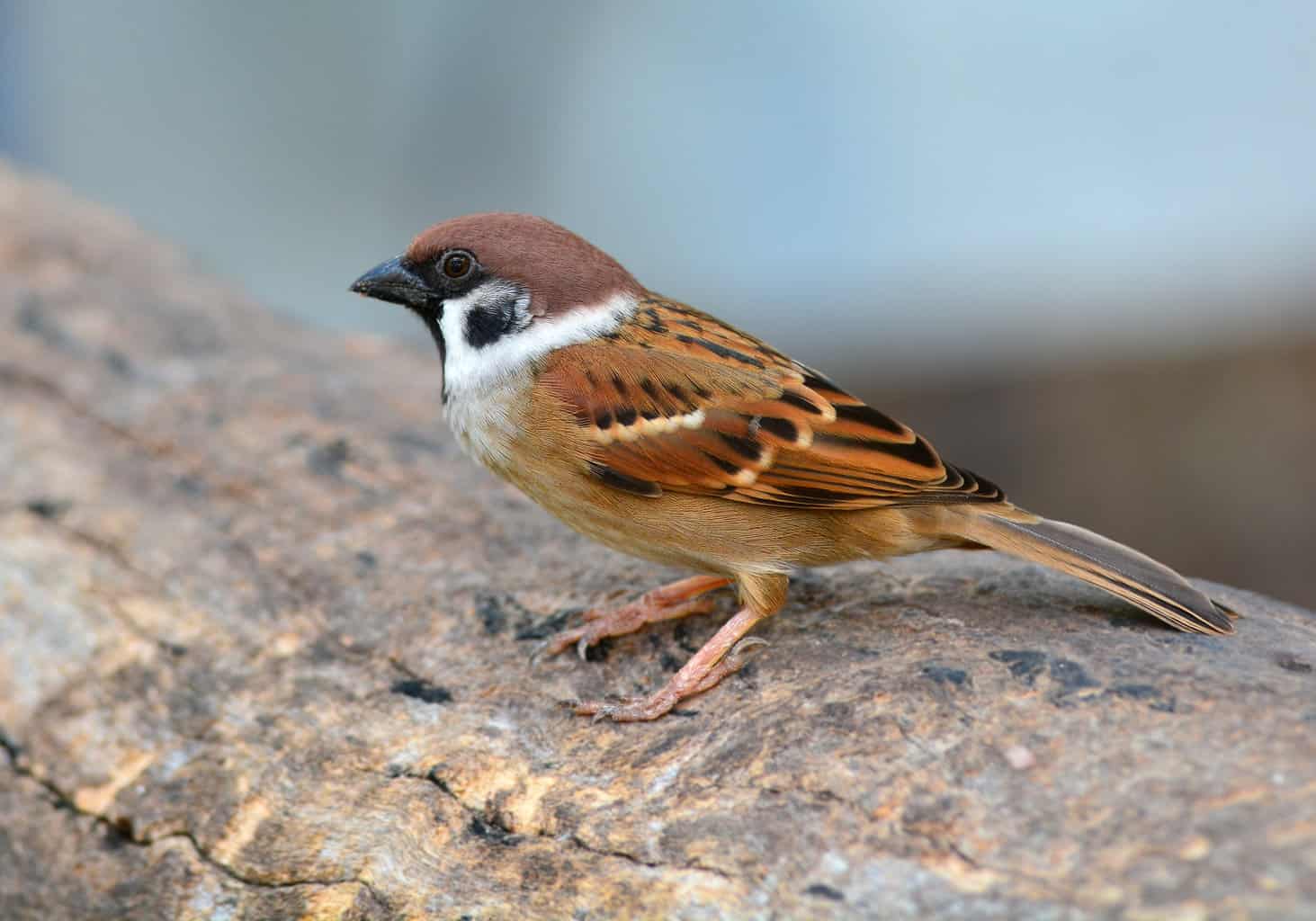
- Passer montanus
- Length: 5.5-5.9 inches
- Weight: 0.6-1.0 ounces
- Wingspan: 7.9-8.7 inches
The most closely related sparrow in North America to the house sparrow is another non-native bird, the Eurasian tree sparrow.
From 12 sparrows released in the 1800’s around the St. Louis area, Eurasian tree sparrows haven’t spread across the country like wildfire, as the house sparrow did. Still, they’ve established themselves in areas around St. Louis, including western Illinois and southeastern Iowa.
Look for them in parks and agricultural fields. Though they were released around one of the country’s largest metropolitan areas, they are not as common in cities as their cousins, the house sparrow.
Like house sparrows, they have blocky bodies. Both males and females also resemble male house sparrows, with chestnut-brown heads, black and white faces, and wings of darker brown and black that contrast against their light undersides.
American Tree Sparrow
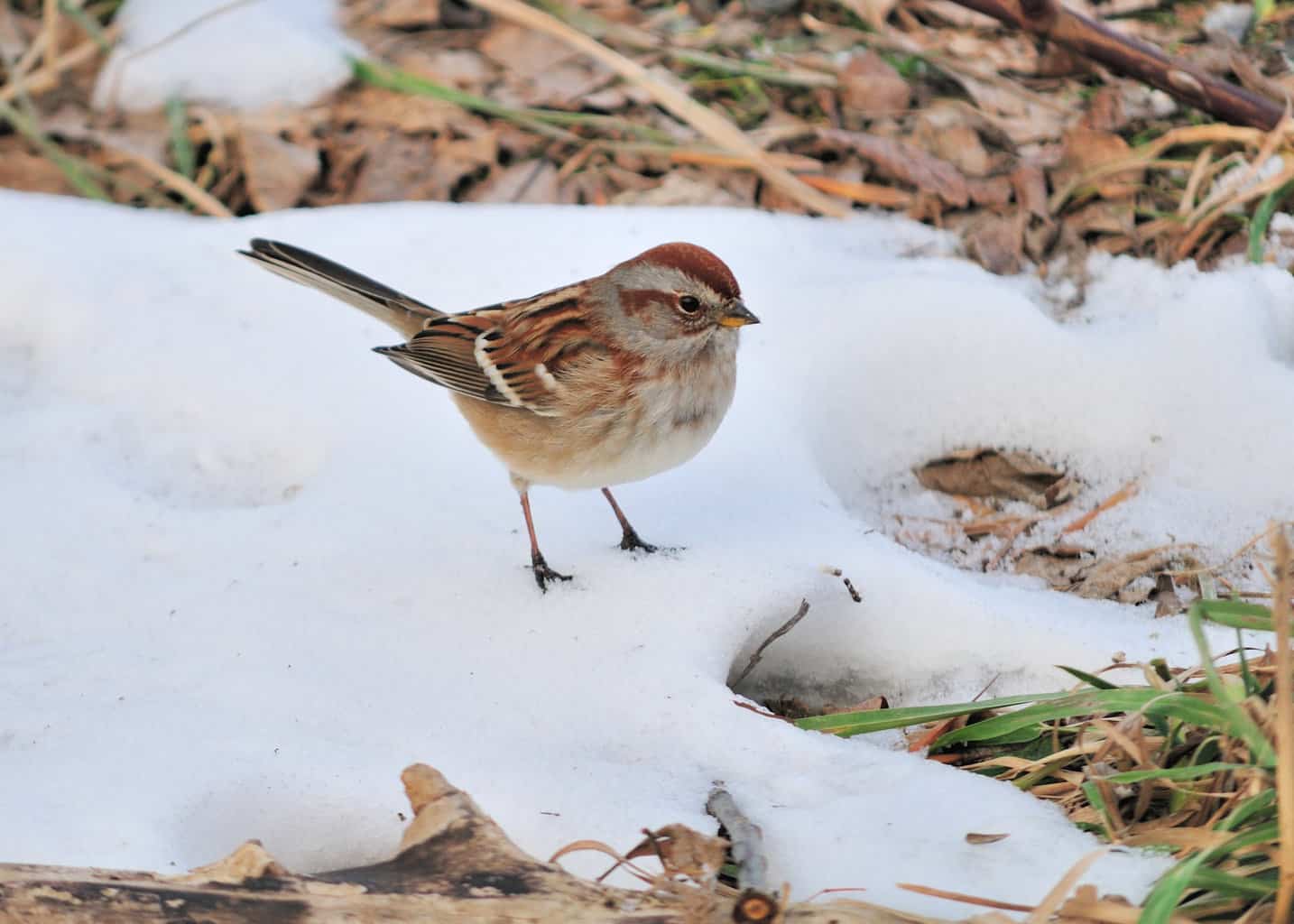
- Spizelloides arborea
- Length: 5.5 inches
- Weight: 0.5-1.0 ounces
- Wingspan: 9.4 inches
Next up is our resident tree sparrow here in North America, though residents of the United States should only expect to see them in the winter, as they breed up in northern Canada and Alaska.
As a species, they’re sort of misnamed. According to All About Birds, they were named “tree sparrows” by European settlers who thought the birds reminded them of Eurasian tree sparrows back in Europe. However, these tree sparrows actually spend more time on the ground than they do on trees.
You may see them at your feeders or in agricultural fields during the winter months, picking at a variety of seeds on the ground.
A rather round sparrow, American tree sparrow males and females look the same. They have a couple of notable markings, including a rufous-brown cap, a dark spot right in the middle of the chest, a bill that’s half black and half yellow, and another rufous streak running from the eye back toward the back of the head.
Chipping Sparrow
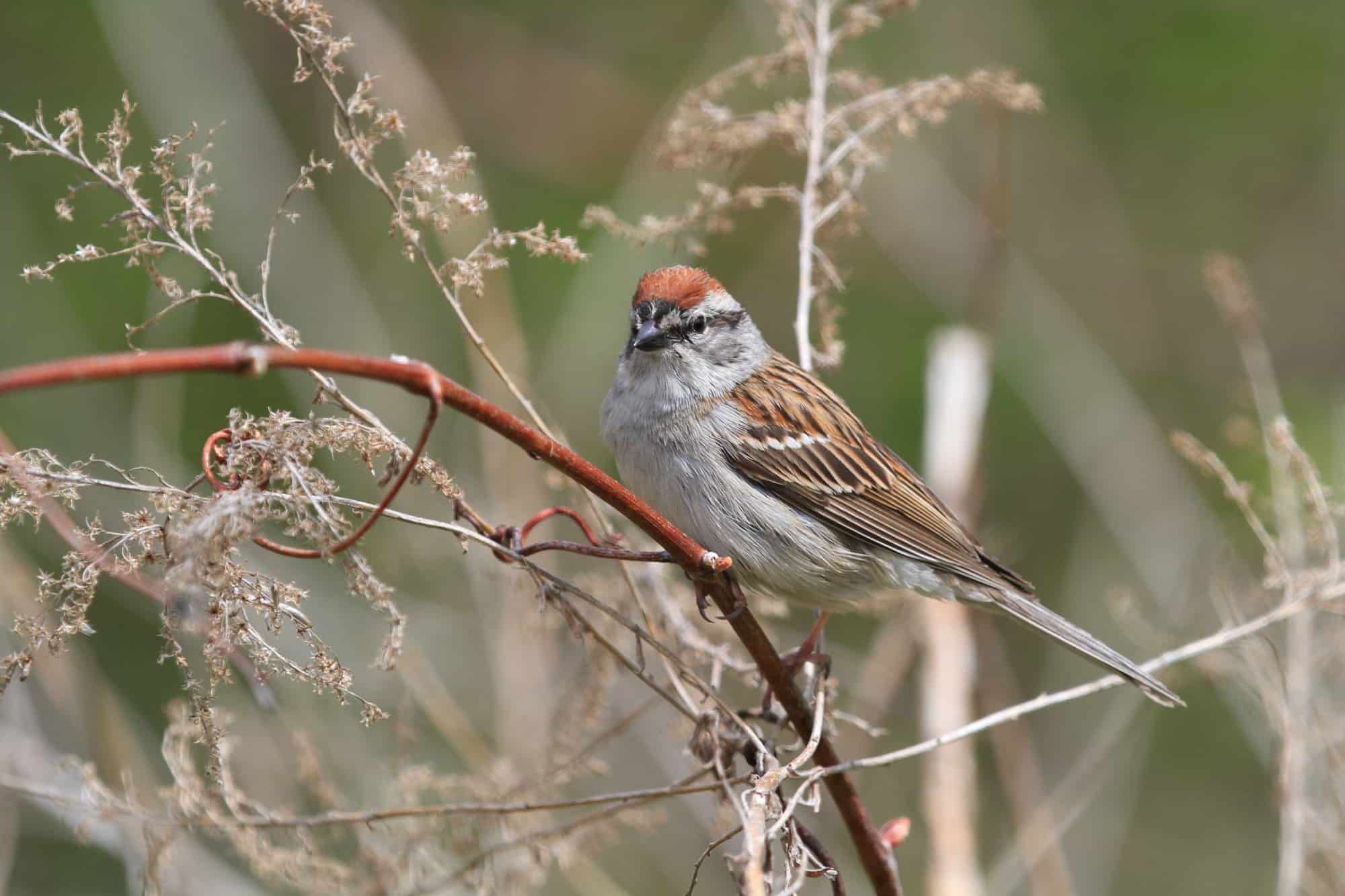
- Spizella passerina
- Length: 4.7-5.9 inches
- Weight: 0.4-0.6 ounces
- Wingspan: 8.3 inches
You can tell by the length and weight difference between the aforementioned sparrows and the chipping sparrow one key thing that sets chipping sparrows apart from American tree sparrows. Chipping sparrows are often smaller.
Chipping sparrows have a rufous cap just like the American tree sparrow, with a plain gray belly. Where the American tree sparrow has a rufous eyeline, the chipping sparrow has a dark line. The eyeline is slightly darker and the cap is redder in breeding birds than in non-breeding birds.
Chipping sparrows are common breeding residents of Iowa. They can be found in many places, including parks, backyards, and fields. They may also visit feeders, either on the feeder or feeding off leftover seeds on the ground.
Field Sparrow
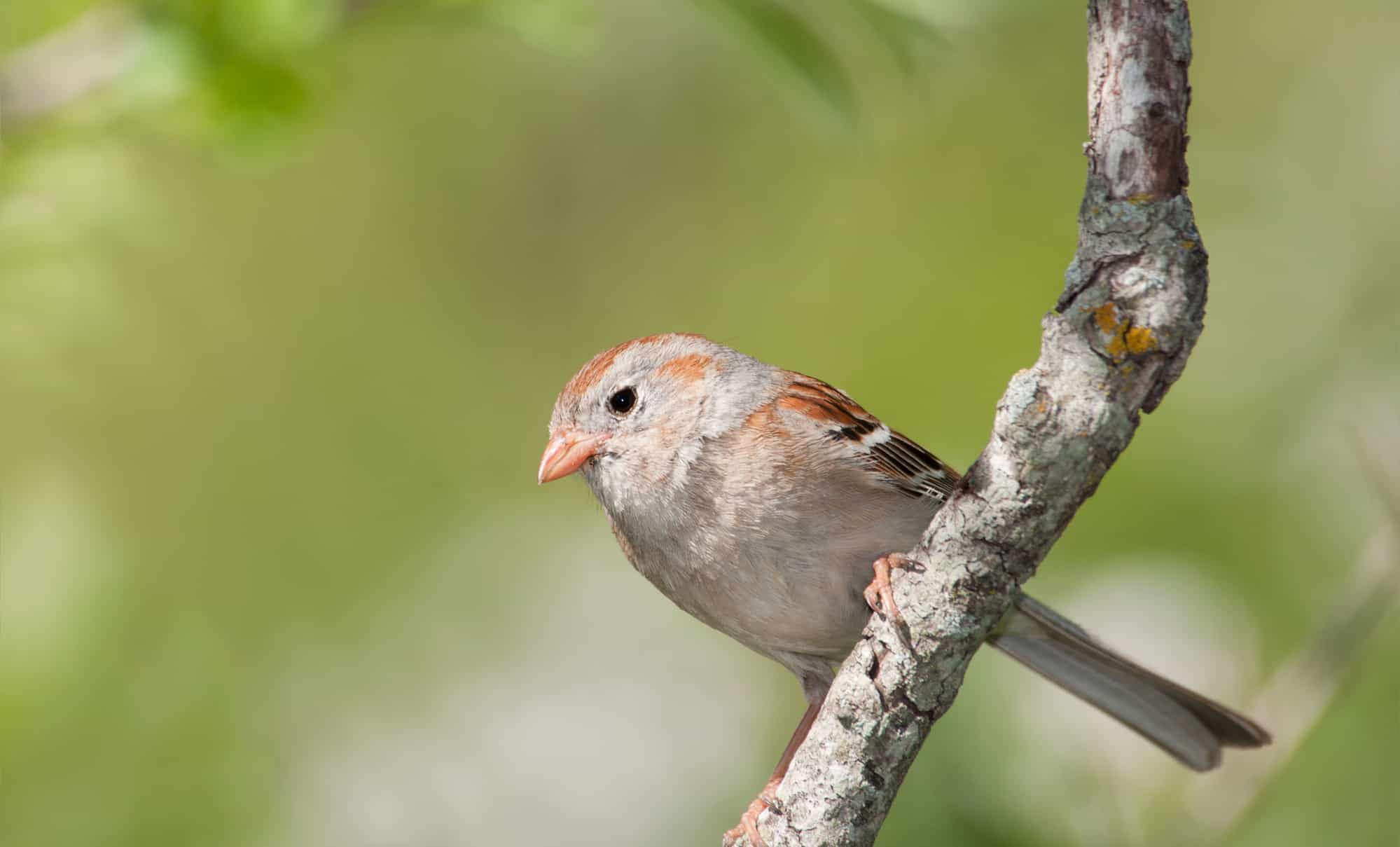
- Spizella pusilla
- Length: 4.7-5.9 inches
- Weight: 0.4-0.5 ounces
- Wingspan: 7.9 inches
While the American tree sparrow was a bit misnamed, that’s not the case with the field sparrow, a small resident of prairies and open areas from the Great Plains through the East Coast.
Iowa is generally in the breeding range for field sparrows, with the occasional winter stay-overs.
When taking a walk through the prairie, listen for their beautiful song, a group of whistles that become much shorter and closer together as the song draws to a close in a trill.
The field sparrow has a rusty color cap and line behind the eye like the tree sparrow, but their bill colors can help you tell them apart. While the tree sparrow’s bill is black on top and yellow on the bottom, the field sparrow has a pinkish bill.
Across the continent, field sparrows are in a serious population decline, spurred by the loss of fields and prairies in place of suburbs, according to All About Birds.
Swamp Sparrow
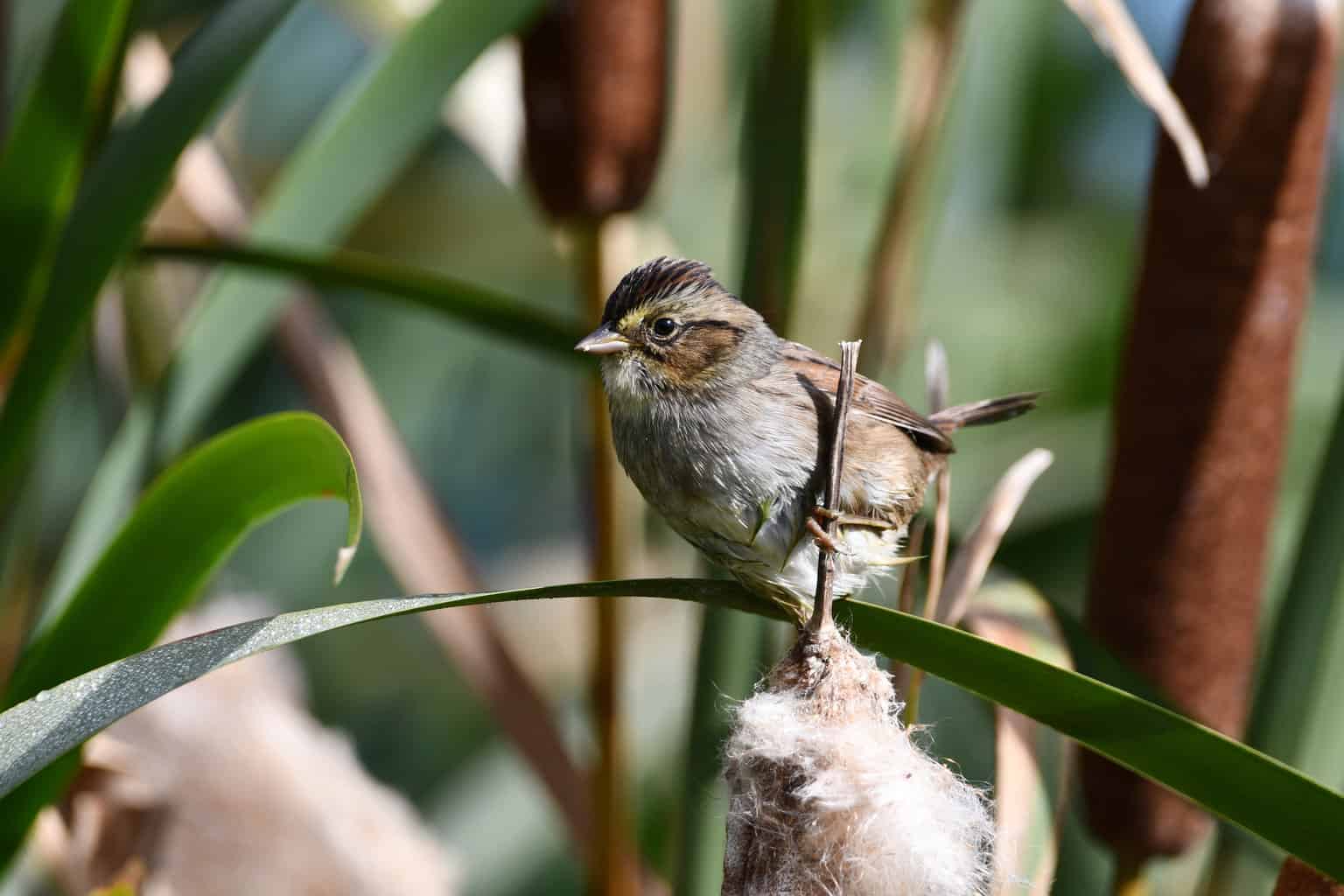
- Melospiza georgiana
- Length: 4.7-5.9 inches
- Weight: 0.5-0.8 ounces
- Wingspan: 7.1-7.5 inches
The swamp sparrow’s cap is darker than other previous sparrows on the list, even darker than the chipping sparrow. Like chipping sparrows, swamp sparrows have a dark line behind the eye. And like the field sparrow, their bills are a darker color on top, with the bottom half a lighter yellow.
Their wings are red-brown, with gray and brown intermixed on the chest and belly.
Iowa is on the southern end of the swamp sparrow’s breeding range, although some Iowans might have swamp sparrows spend the whole year near them.
Look for them in swamps, marshes, or any other place where there’s shallow water intermixed with dense vegetation, such as cattail ponds.
Lincoln’s Sparrow
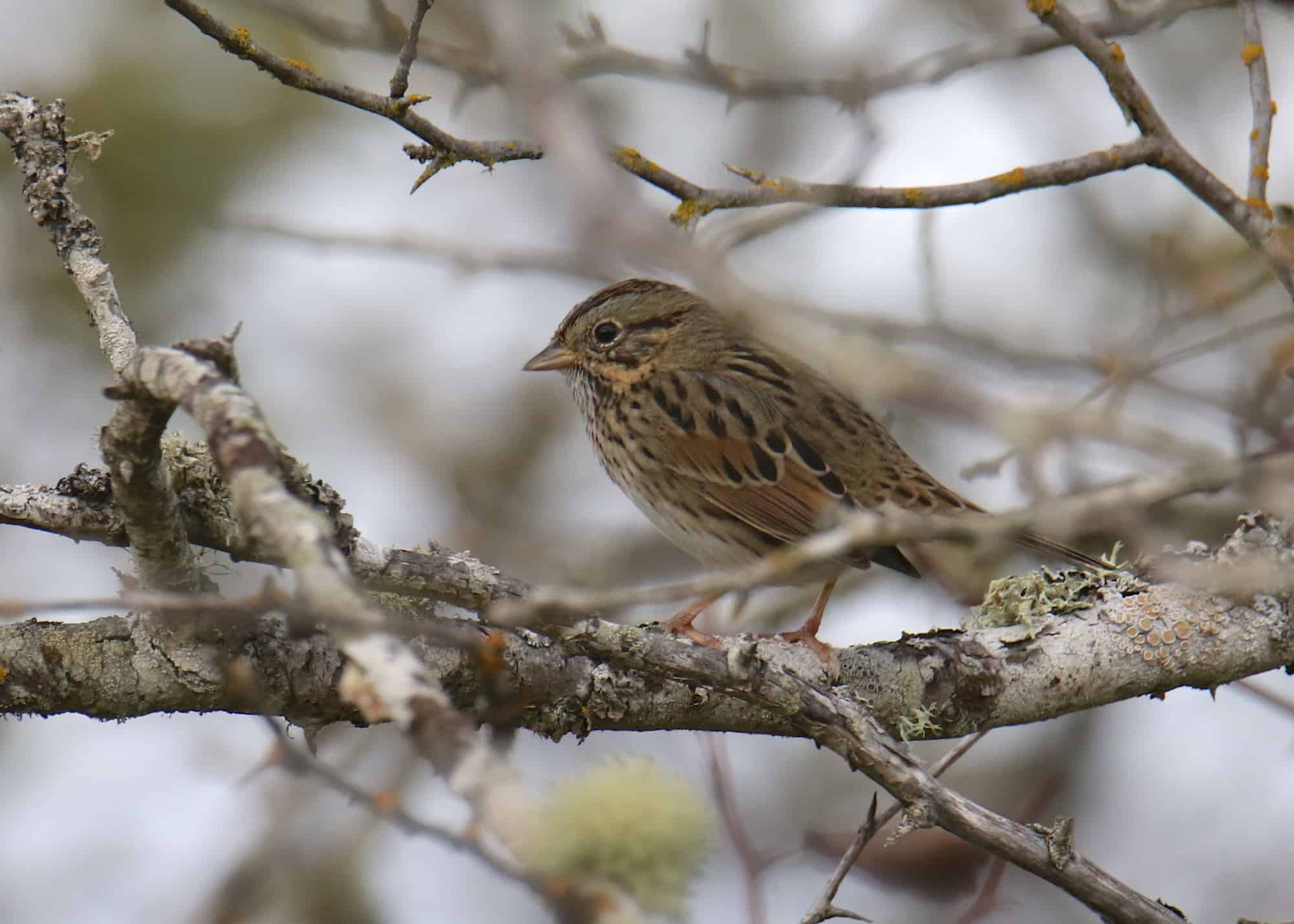
- Melospiza lincolnii
- Length: 5.1-5.9 inches
- Weight: 0.6-0.7 ounces
- Wingspan: 7.5-8.7 inches
Sporting a similar cap and eyeline to the swamp sparrow, Lincoln’s sparrows are much streakier than swamp sparrows, with dark streaks running vertically down their chests.
Iowa is flyover country for Lincoln’s sparrows, so your best bet to see one is to keep your eyes peeled during fall and spring migrations.
Keep your eyes trained low to the ground in areas like bushes, as that’s where you’re most likely to find these streaked birds.
Song Sparrow

- Melospiza melodia
- Length: 4.7-6.7 inches
- Weight: 0.4-1.9 ounces
- Wingspan: 7.1-9.4 ounces
Another bird with a streaked chest is the song sparrow, a year-round resident for all areas of the Hawkeye State.
Their songs frequently ring out in a variety of habitats, including marshes, fields, and streamsides. You may also see them at backyard feeders.
Their brown chest streaks end before the underbelly, sometimes in a larger dark spot. They also have brown streaks on their head, behind the eye, somewhat less noticeably, down the back of the head and back.
Song sparrow patterns and colors vary greatly across North America, but the ones in Iowa will typically have stripes that are lighter in color and thicker in width than those of Lincoln’s sparrows.
Fox Sparrow

- Passerella iliaca
- Length: 5.9-7.5 inches
- Weight: 0.9-1.6 ounces
- Wingspan: 10.5-11.4 inches
Fox sparrows, named for their red-brown markings, are migratory and winter visitors to Iowa, where they may visit bird feeders or be seen along hikes in natural areas.
Maps on eBird are dotted with annual sightings in the greater Cedar Rapids, Iowa City, Waterloo, and Des Moines areas at places like Hawkeye Wildlife Management Area, Wickiup Hill Learning Center, George Wyth State Park, and Oak Grove Recreation Area, among others.
Fox sparrows are rather big as far as sparrows go, with coarse streaks of a reddish brown compared to some of the finer streaking of other species. Their bills are mostly yellow with some darker coloring mixed in. Intermixed with brown on their faces is gray coloring above the eye.
Clay-colored Sparrow
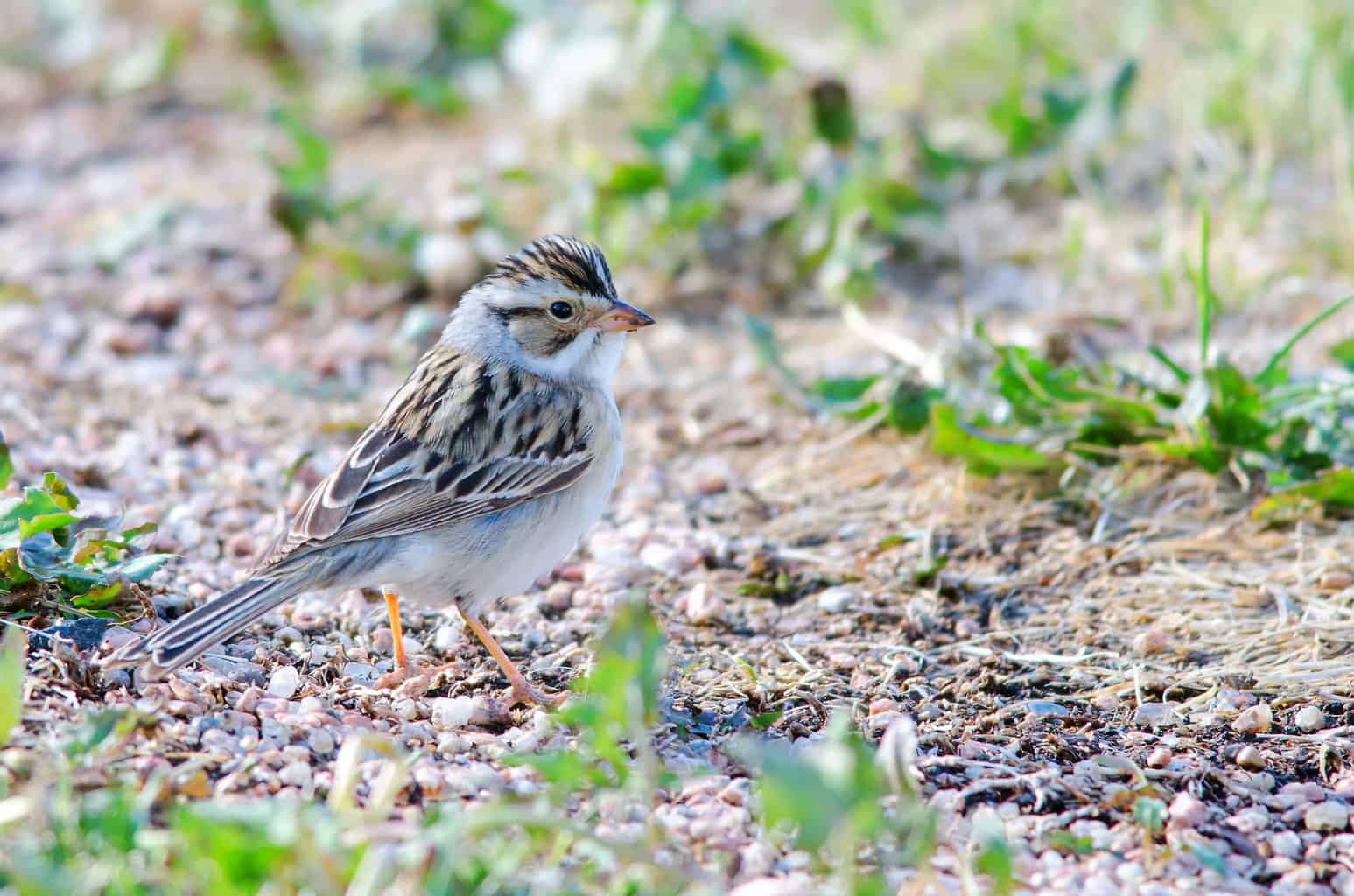
- Spizella pallida
- Length: 5.5 inches
- Weight: 0.42 ounces
- Wingspan: 7.5 inches
(Measurements via The Sibley Guide to Birds)
The southern border of the clay-colored sparrow’s breeding range seems to come to an abrupt halt at the Minnesota-Iowa border, with sightings increasing as you go north through the Dakotas and Canada.
Iowa sightings mostly come during migration, and eBird users do sometimes report them in green areas around populated areas like Des Moines, Ames, and Iowa City, for example.
Both breeding and non-breeding birds are relatively unmarked on their chests and bellies.
They have long tails, brown streaks on the head and back, and a “mustache” mark starting at the bottom of the bill that looks white in breeding adults and pale tan in non-breeding/immature birds.
Between their streaky brown backs and heads is a gray nape, a fairly uncommon marking for a sparrow.
Savannah Sparrow
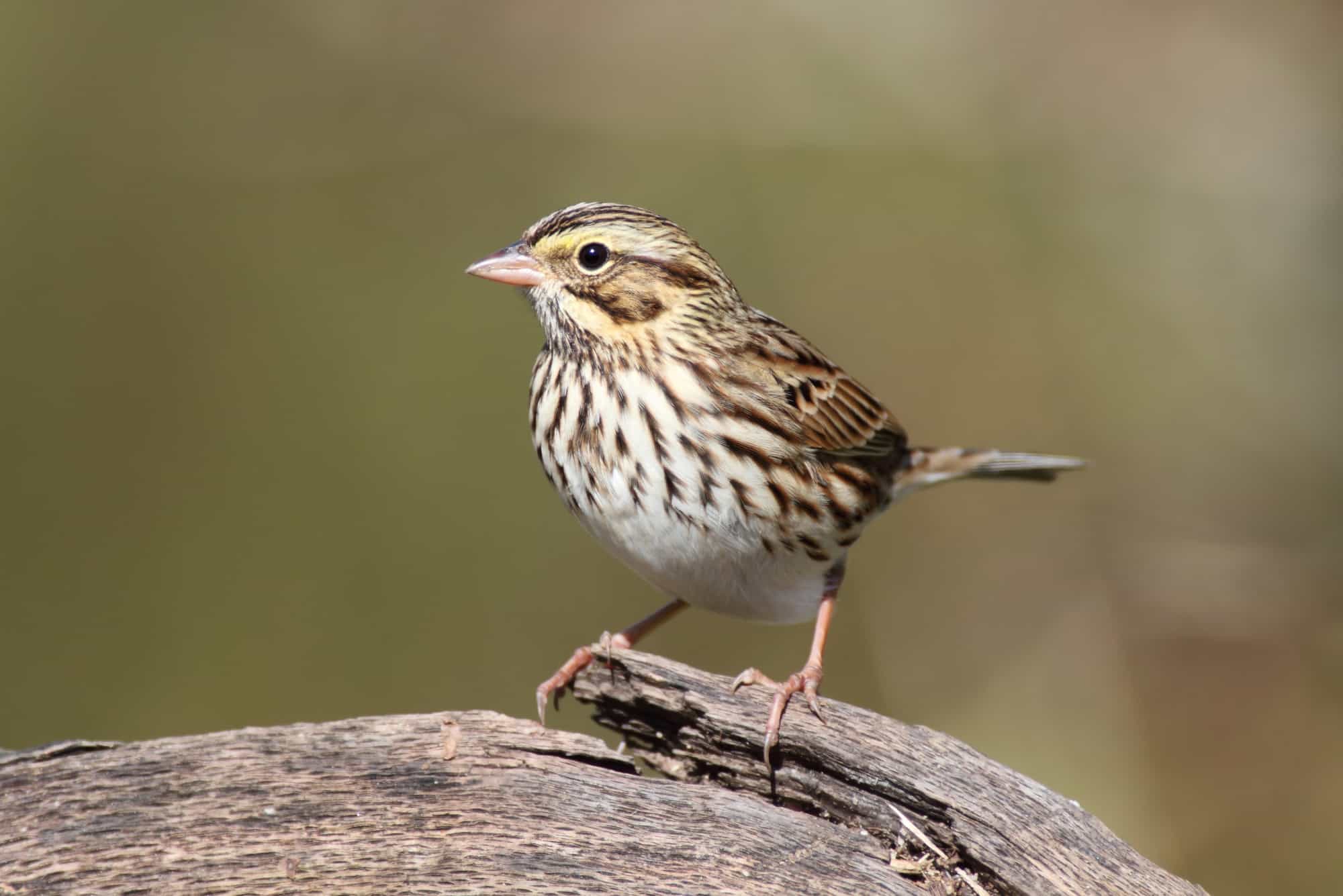
- Passerculus sandwichensis
- Length: 4.3-5.9 inches
- Weight: 0.5-1.0 ounces
- Wingspan: 7.9-8.7 inches
The distinguishing mark on the Savannah sparrow is without a doubt a little yellow mark right near the eye. Savannah sparrows are streaked overall, with streaks fading to white toward the belly.
Iowa is on the southern outskirts of the Savannah sparrow’s breeding range. Summer reports from eBird users start to taper off at the Minnesota state line.
You’re more likely to see them as they migrate. As they make their yearly movements, they’ll stop to feed, mostly off the ground. Farm fields and areas near them give you chances to see them during this time.
In northern Iowa, where these birds more commonly breed, look for them in prairies and agricultural fields. Keep your eyes and ears trained to fence posts and brush nearby and you might get a glimpse of a Savannah sparrow.
Grasshopper Sparrow
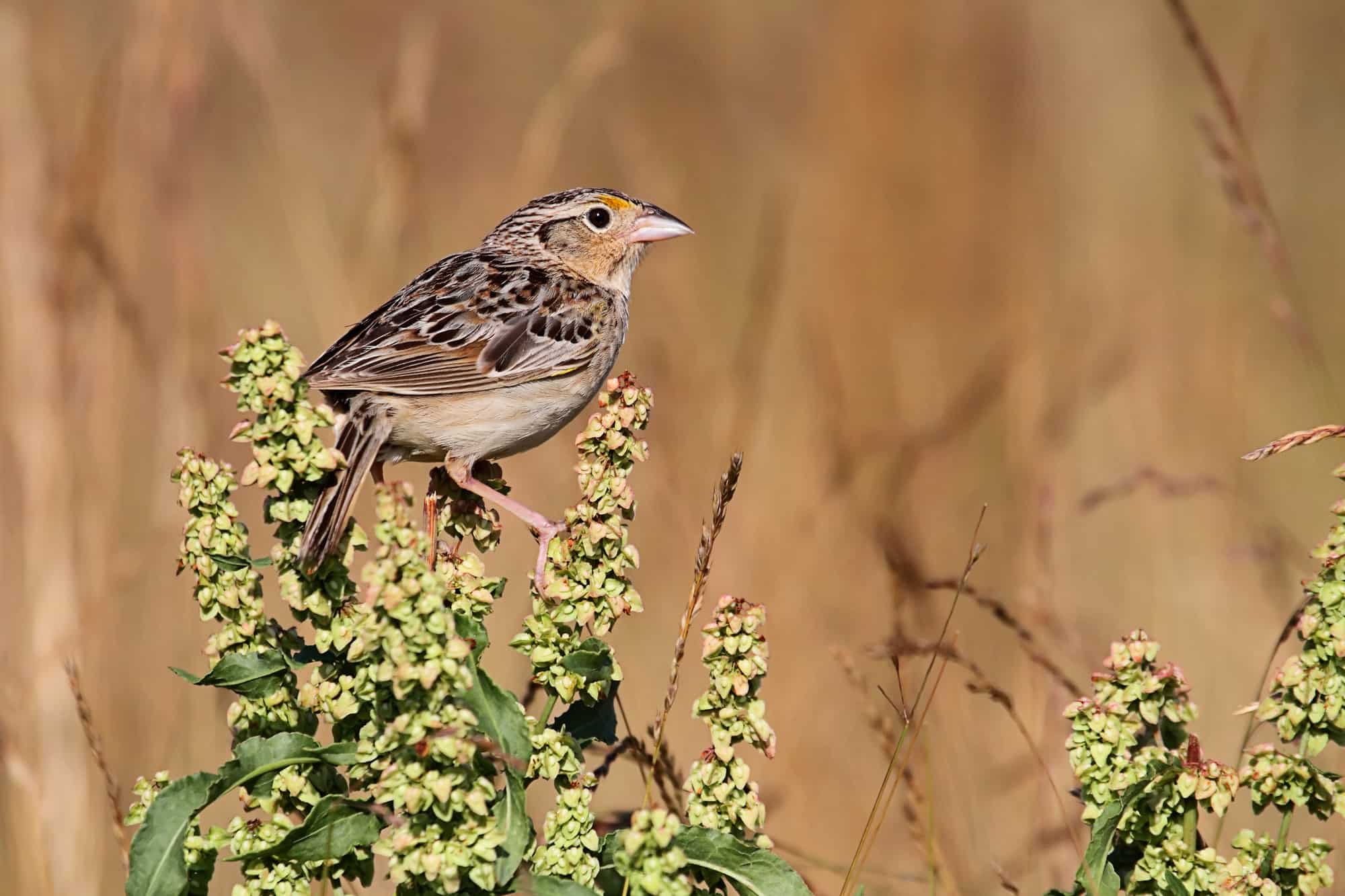
- Ammodramus savannarum
- Length: 4.3-4.5 inches
- Weight: 0.5-0.7 ounces
- Wingspan: 7.9 inches
Grasshopper sparrows also have a yellow stripe around the eyebrow area, but theirs is more of an orange-brown than the Savannah sparrow’s.
You can sometimes see a little bit of yellow along the edges of their wings as well, moreso in a photo than looking through a set of binoculars as a four-inch bird bounces around in front of you.
Their chests and bellies are relatively streak-free compared to some of the recent birds we’ve looked at. Grasshopper sparrows have thick necks and very short tails.
The Hawkeye State is right in the middle of the grasshopper sparrow’s breeding range, but these little sparrows are tough birds to spot.
While grasshoppers are also a key part of this bird’s diet, their song is almost grasshopper-esque as well. Listening for them is one way you can increase your chances of getting close enough to spot them.
LeConte’s Sparrow
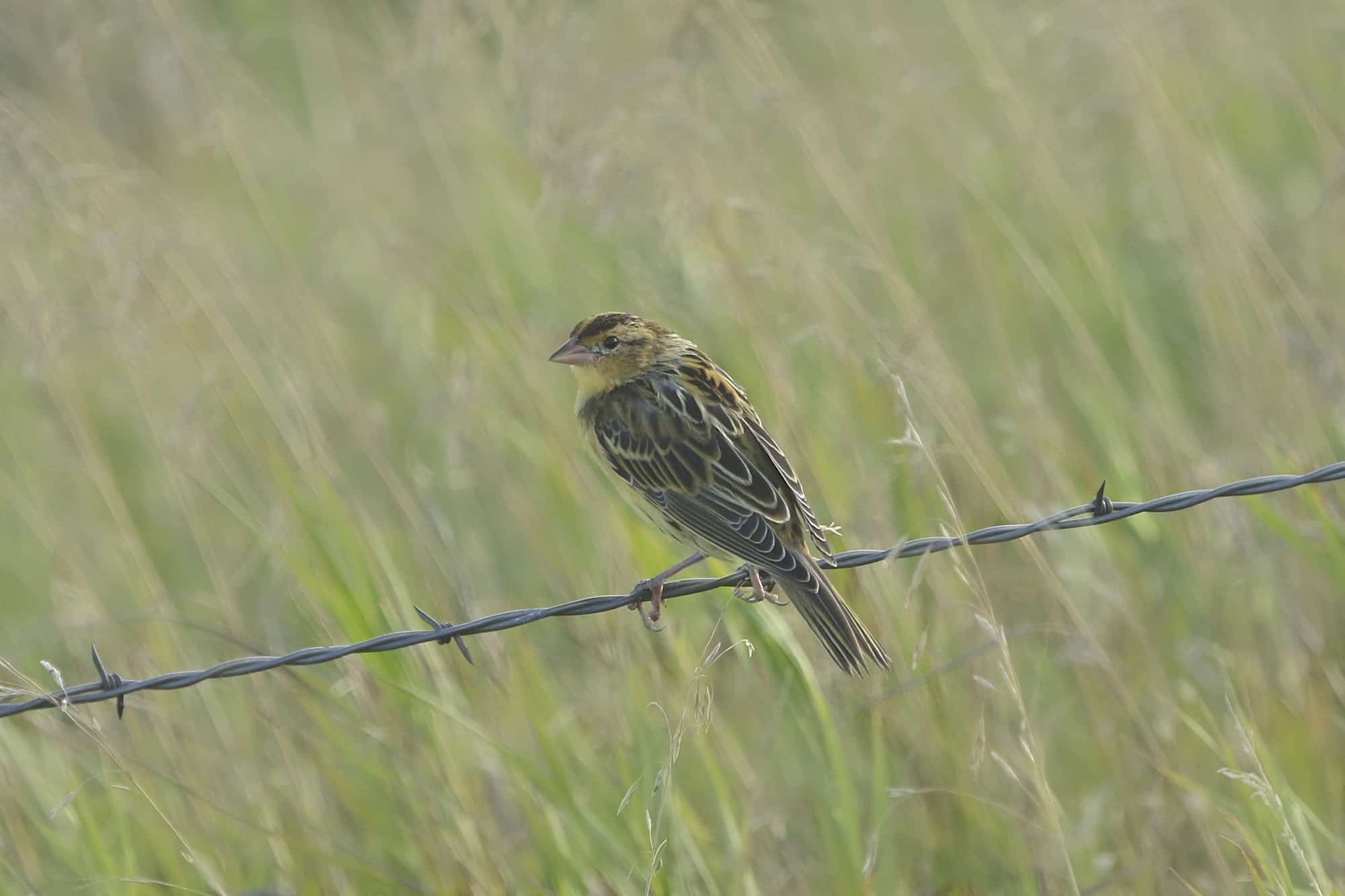
- Ammospiza leconteii
- Length: 4.7-5.1 inches
- Weight: 0.4-0.6 ounces
- Wingspan: 6.3-7.1 inches
LeConte’s sparrows have a pretty restricted range through the center of North America, so states like Nebraska, Iowa, and most of Illinois are mostly just migration stops for these birds on their way to and from breeding grounds in the north and wintering grounds in the south.
Your chances of finding a LeConte’s sparrow anywhere, let alone finding one in Iowa, are low, as they’re very secretive birds.
According to All About Birds, the first time the species was described was in 1790, but it took almost 100 years before scientists found the first LeConte’s nest.
LeConte’s sparrows are a bit more colorful than the average sparrow, with stretches of light orange across much of the face and body.
Their chests and bellies are relatively unmarked. They have a dark eyeline that grows in stature approaching the back of the head and black stripes running over the top of the head.
Henslow’s Sparrow
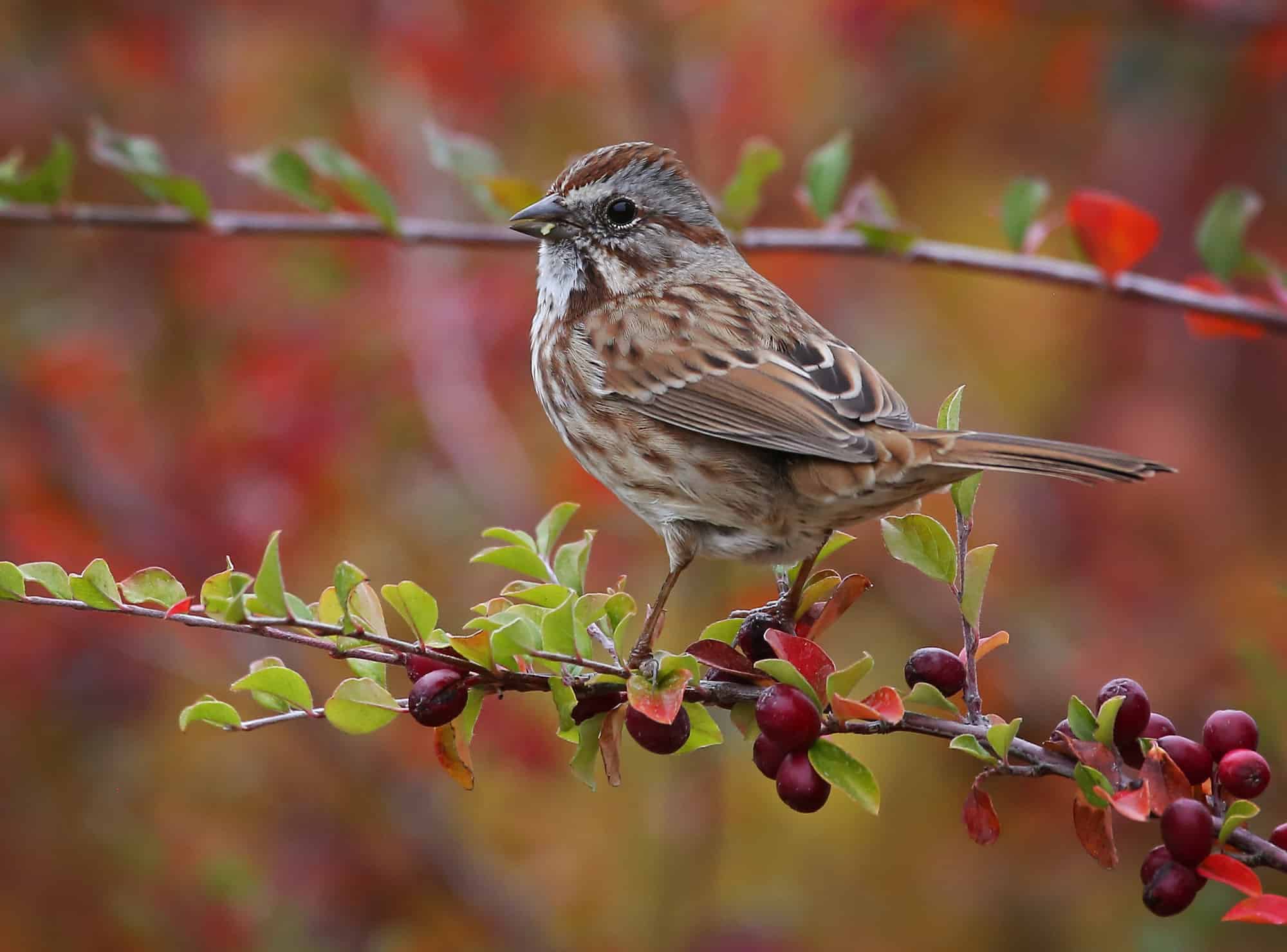
- Centronyx henslowii
- Length: 4.3-5.1 inches
- Weight: 0.4-0.5 ounces
- Wingspan: 6.3-7.9 inches
Henslow’s sparrows have a little bit of yellow to their face as well, and you’re more likely to see one of them than a LeConte’s sparrow, as they’re breeding residents of eastern Iowa.
Still, they spend a lot of time in dense grasslands and fields, so you won’t have much luck finding them unless they break their cover.
While not the only place to spot them, they have been reported by eBird users every summer for the last couple of years at Hawkeye Wildlife Management area, located along I-380 between Cedar Rapids and Iowa City.
As for identification, dark markings form a near-enclosed circle behind the eye that’s often darker than the rest of the face. Their upper chests feature thin streaky markings.
Nelson’s Sparrow
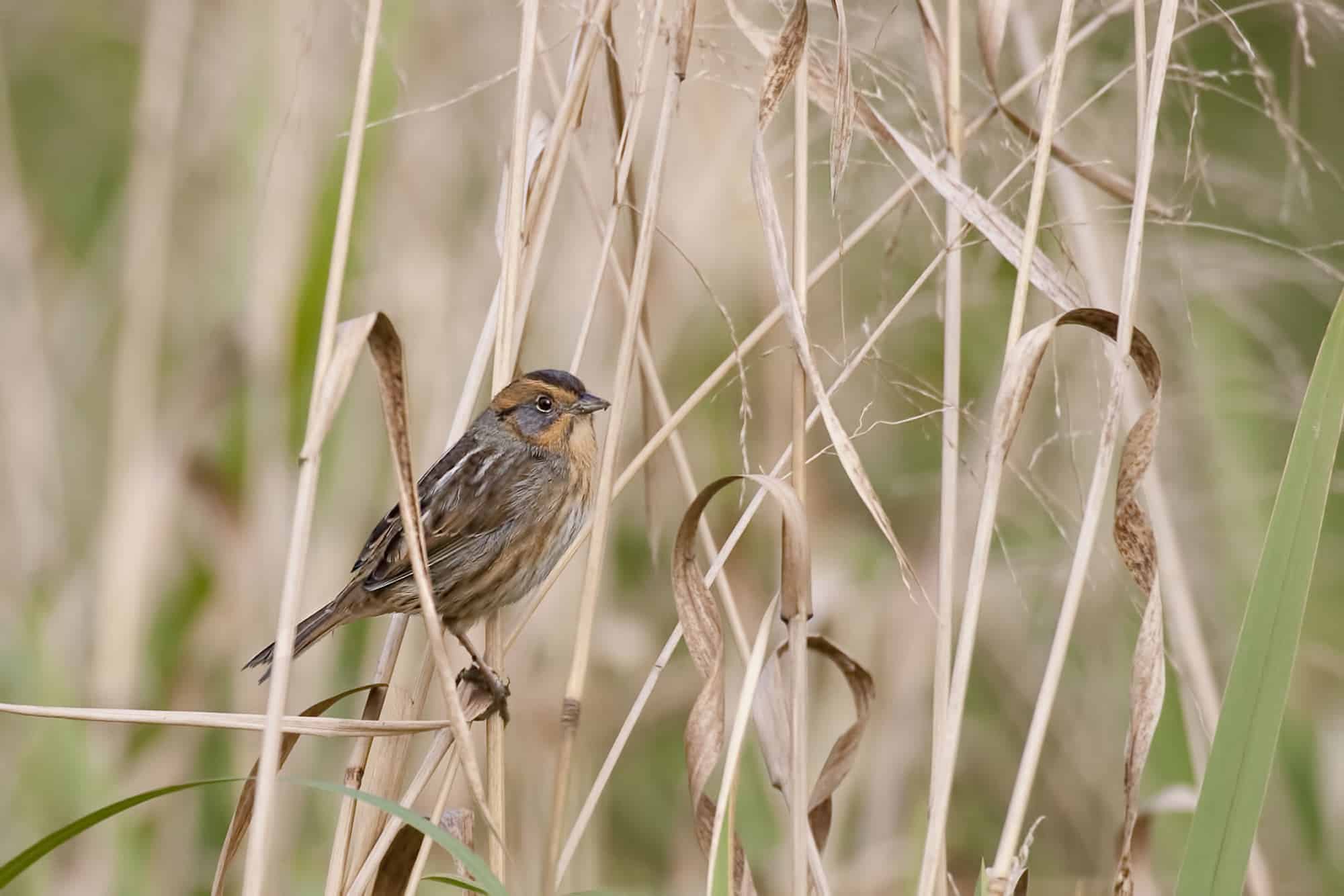
- Ammospiza nelsoni
- Length: 4.3-5.1 inches
- Weight: 0.6-0.7 ounces
- Wingspan: 6.5-7.9 inches
One rarely-reported bird in Iowa is Nelson’s sparrow, which passes through the state on its migration routes to and from marshy areas along the Gulf Coast and the Atlantic Ocean.
When in the state, they’re most likely to be spotted on or near the ground.
Adults have bright yellow-orange faces that lighten slightly in color as they meet darker streaks along the chest. They have white bellies.
Intermixed with the yellow-orange face colors are gray patches under the eye and on the nape.
Vesper Sparrow
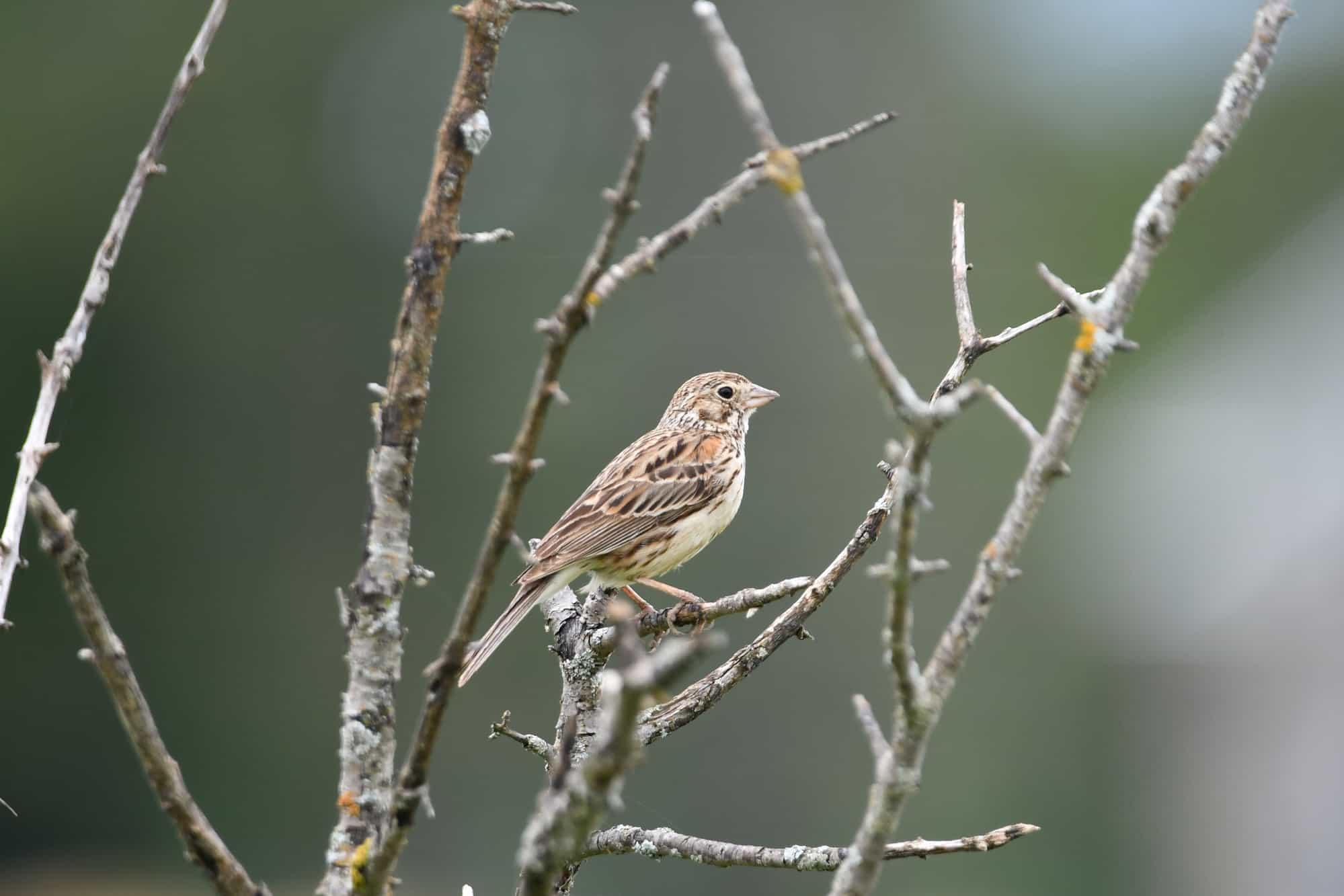
- Pooecetes gramineus
- Length: 5.1-6.3 inches
- Weight: 0.7-1.0 ounces
- Wingspan: 9.4 inches
The vesper sparrow is the only bird in the genus Pooecetes, meaning ‘grass dweller,’ according to All About Birds.
Areas of low grass in prairies, meadows, and agricultural fields provide vesper sparrow habitat, and you’ll have the best chance to see them on or near the ground.
Look for a white eyering on a streaky brown sparrow, along with a unique tail pattern. The outer tail feathers are white, serving as bookends of an otherwise brown tail.
One more identifiable marking on adult vesper sparrows is a little light brown shoulder patch that’s often difficult or even impossible to see. The other two features give you a better chance at a positive ID on one.
Lark Sparrow
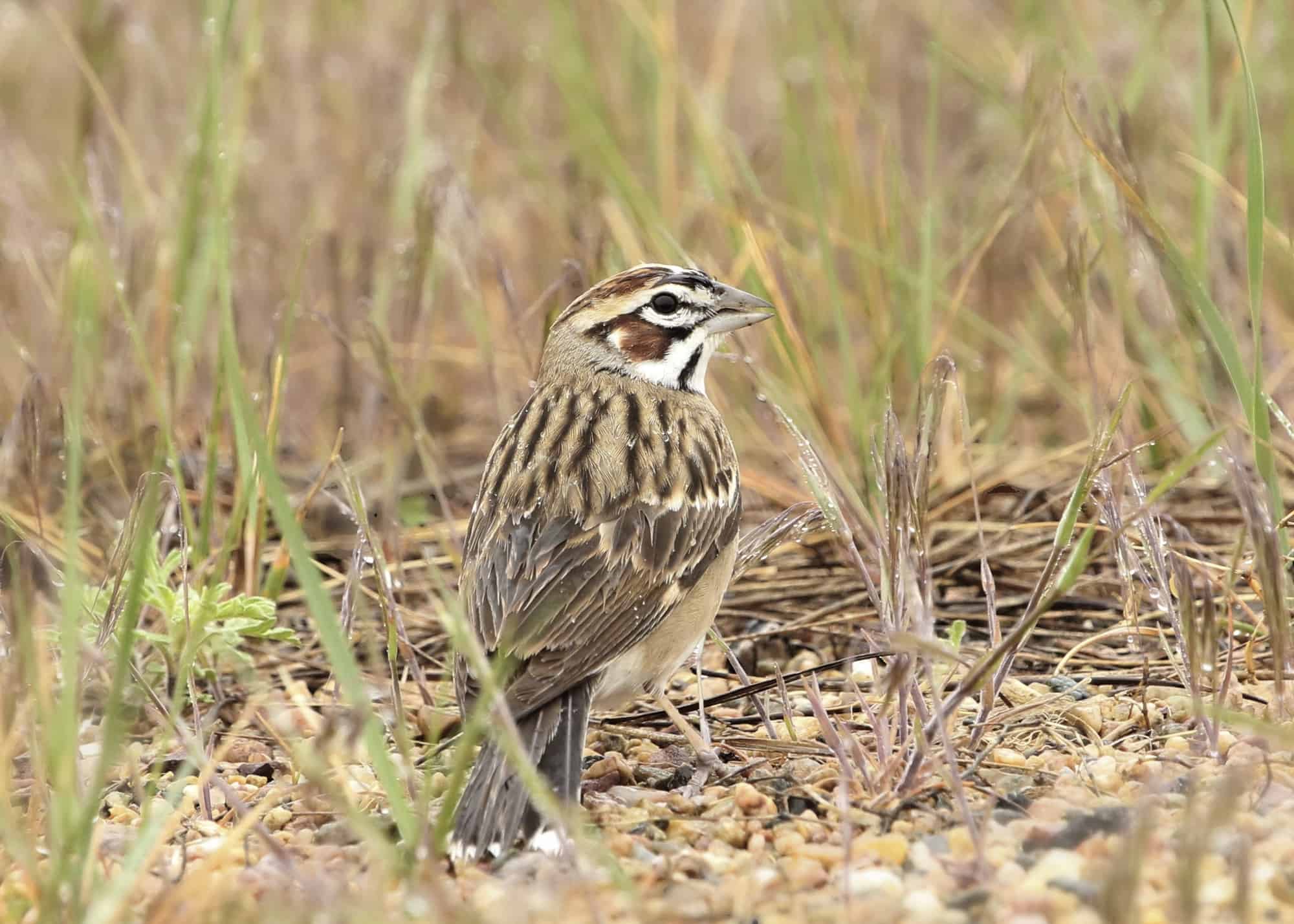
- Chondestes grammacus
- Length: 5.9-6.7 inches
- Weight: 0.8-1.2 ounces
- Wingspan: 11.0 inches
Adult lark sparrows have bold patterns that set them apart from any sparrow we’ve touched on so far.
Aside from a single dark spot in the center of the chest, they don’t have much in terms of markings on their front. Although from a back view, you could get a look at their pretty tails, which have white corners and dark colors elsewhere.
The head and neck area is full of sharp markings. A white mohawk stripe right in the front of the face is flanked by brown on either side. After a white eyebrow, each side of the face has another brown cheek patch.
After another white stripe, a black stripe running from below the bill to the shoulder finishes off what is a striking set of markings.
Immature lark sparrows resemble other sparrows on the list, with spotting on their chests and bellies, and a not-quite-developed set of colors like the adults.
Much of Iowa is in the lark sparrow’s breeding range, where you can find them in grasslands, pastures, and other open areas.
Harris’s Sparrow
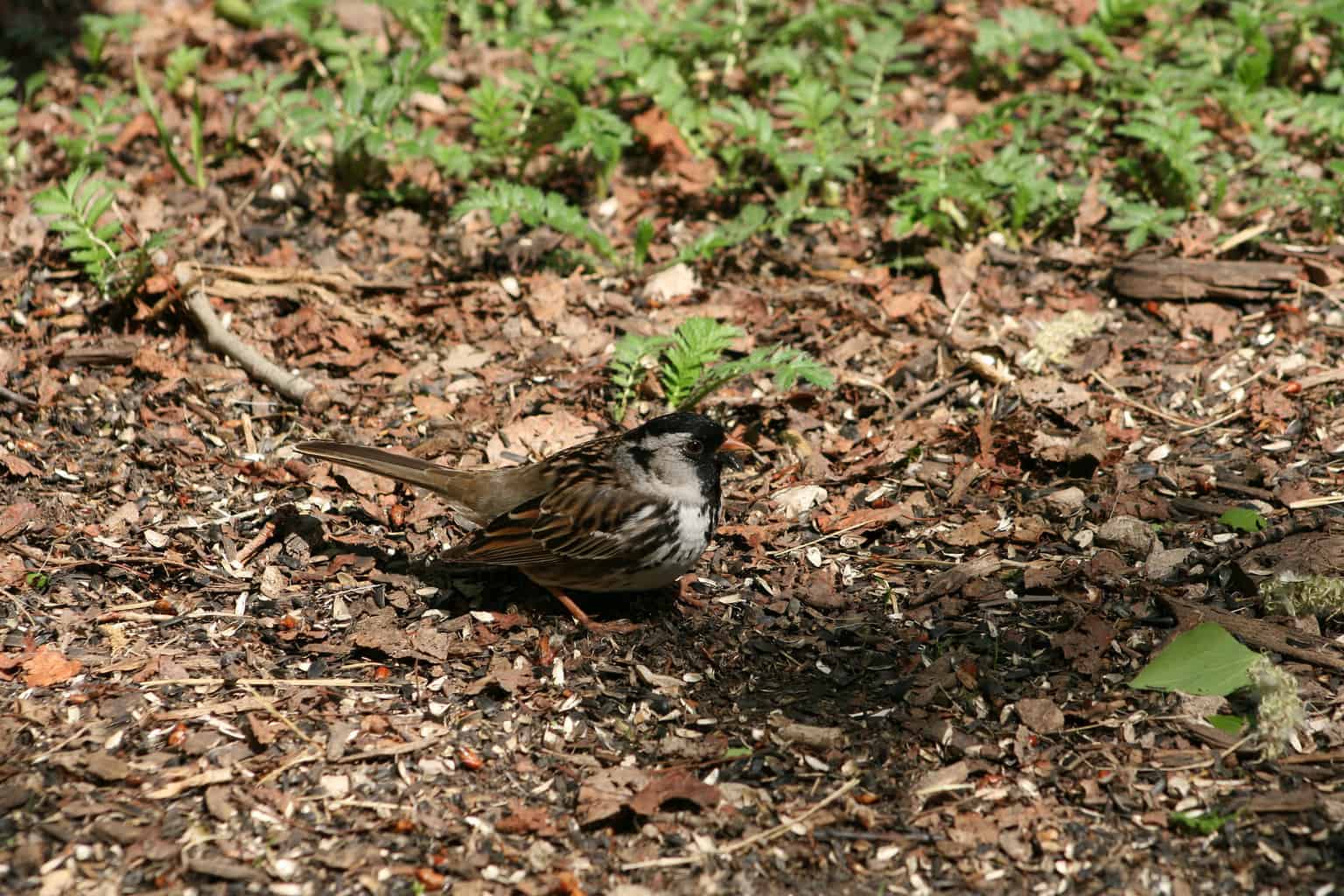
- Zonotrichia querula
- Length: 6.7-7.9 inches
- Weight: 0.9-1.7 ounces
- Wingspan: 10.6 inches
Harris’s sparrows have a comparatively small breeding range in the northern stretches of Canada, starting near the western edge of Hudson Bay and stopping before venturing west to Alaska.
Their wintering grounds are fairly restricted to areas of Nebraska, Kansas, Oklahoma, and Texas, meaning the migration windows are your best bets to see a Harris’s sparrow in most of Iowa. For those living very close to the Nebraska side like near Omaha, Harris’s sparrows could stick around all winter.
According to All About Birds, Harris’s sparrow is the largest sparrow in North America aside from towhees (we’ll touch on them later).
Breeding and non-breeding adults both have pink bills and extensive black plumage covering the central part of the throat, face, and forehead, which should be about all you need to identify them.
Immature birds have the beginnings of a black cap and throat, but not quite fully developed, with tan heads and lighter throats flanked by black stripes pointing down from the start of the bill.
White-crowned Sparrow
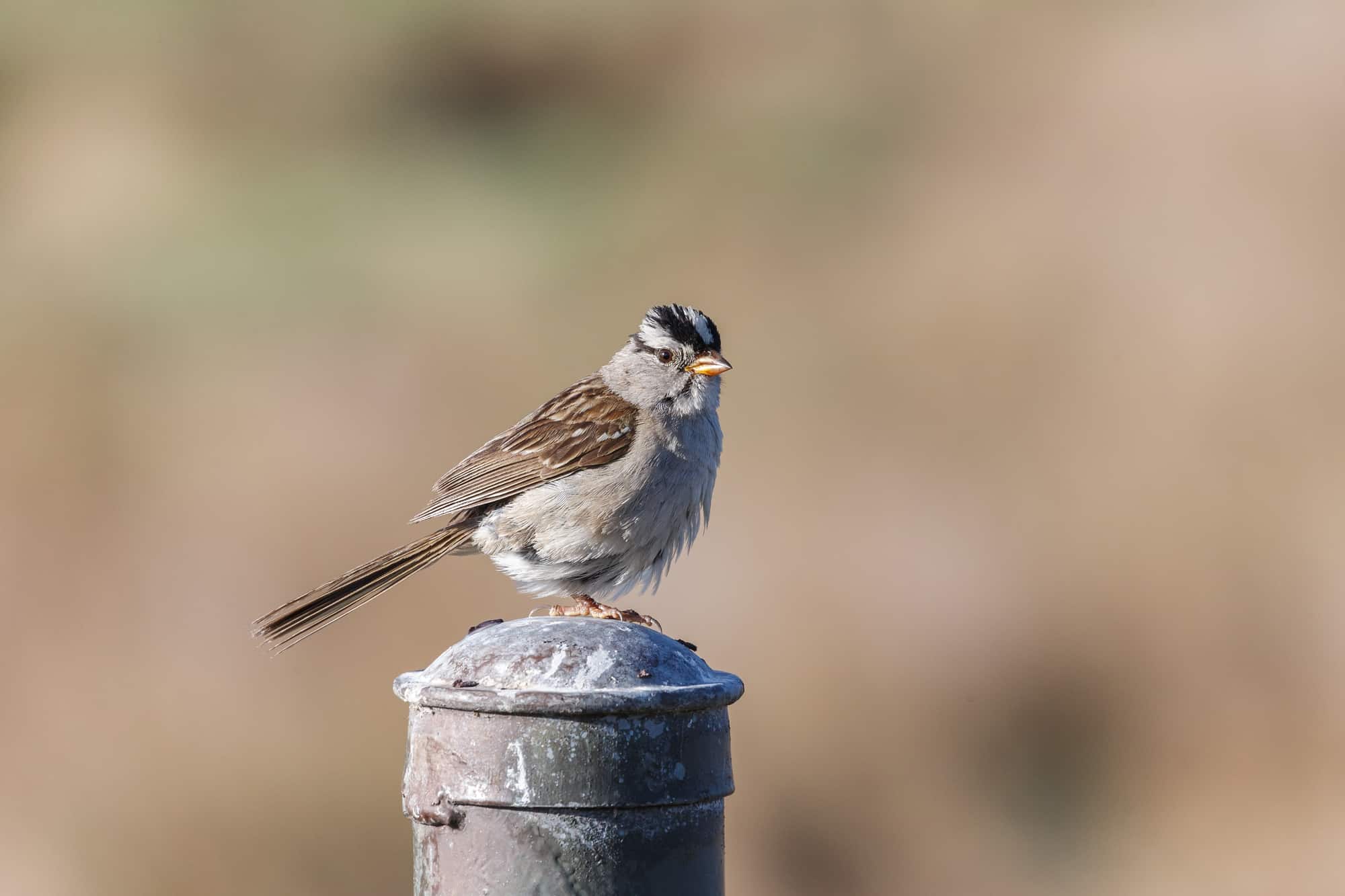
- Zonotrichia leucophrys
- Length: 5.9-6.3 inches
- Weight: 0.9-1.0 ounces
- Wingspan: 8.3-9.4 inches
One adult sparrow that leaves no doubt about its identity is the white-crowned sparrow, a common winter sight in much of Iowa, and a migration stopover in the entire state.
Mature adults have gray bellies, chests, and napes until a black eyeline divides the inconspicuous from the bold white and black cap of the white-crowned sparrow.
Immature white-crowned sparrows’ crowns aren’t actually white yet. Instead, they’re gray with brown stripes in a similar pattern to adults.
White-crowned sparrows start to show up in the fall after heading south from northern breeding grounds in the upper reaches of Canada and Alaska. Some will stop for the year, while others continue south.
They may visit backyards, even around cities and suburbs, though they scatter across the state during their non-breeding season.
White-throated Sparrow
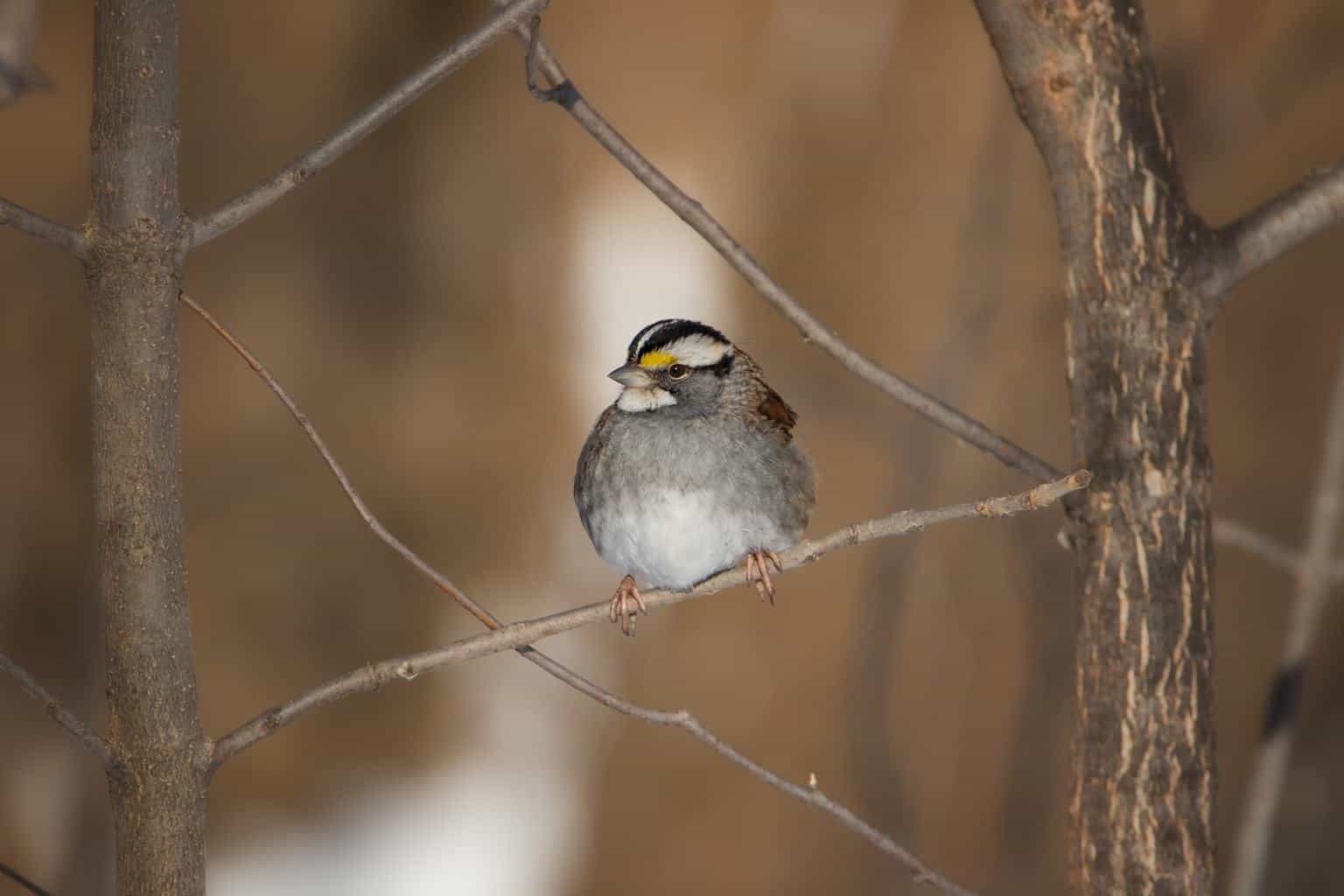
- Zonotrichia albicollis
- Length: 6.3-7.1 inches
- Weight: 0.8-1.1 ounces
- Wingspan: 7.9-9.1 inches
The most similar bird to the white-crowned sparrow is the white-throated sparrow which has – you guessed it – a white throat.
Most have black and white head caps like the white-crowned sparrow, while adults in tan morphs and immature birds will have tan head stripes as opposed to the crisp white color.
On mature adults in their basic form, they have an easily-visible yellow mark just in front of the eye. This is still present but less visible in tan morphs and immature birds.
Iowa is well south of the white-throated sparrow’s breeding range, so look for them starting in the fall.
Though it changes every year, eBird users report them sometimes in big numbers around Saylorville Lake in Polk County and Hickory Grove park in Story County.
That being said, sightings are spread across the state, and they’re often seen in large groups, so you likely don’t have to travel too far to see them during the right time of year.
Dark-eyed Junco
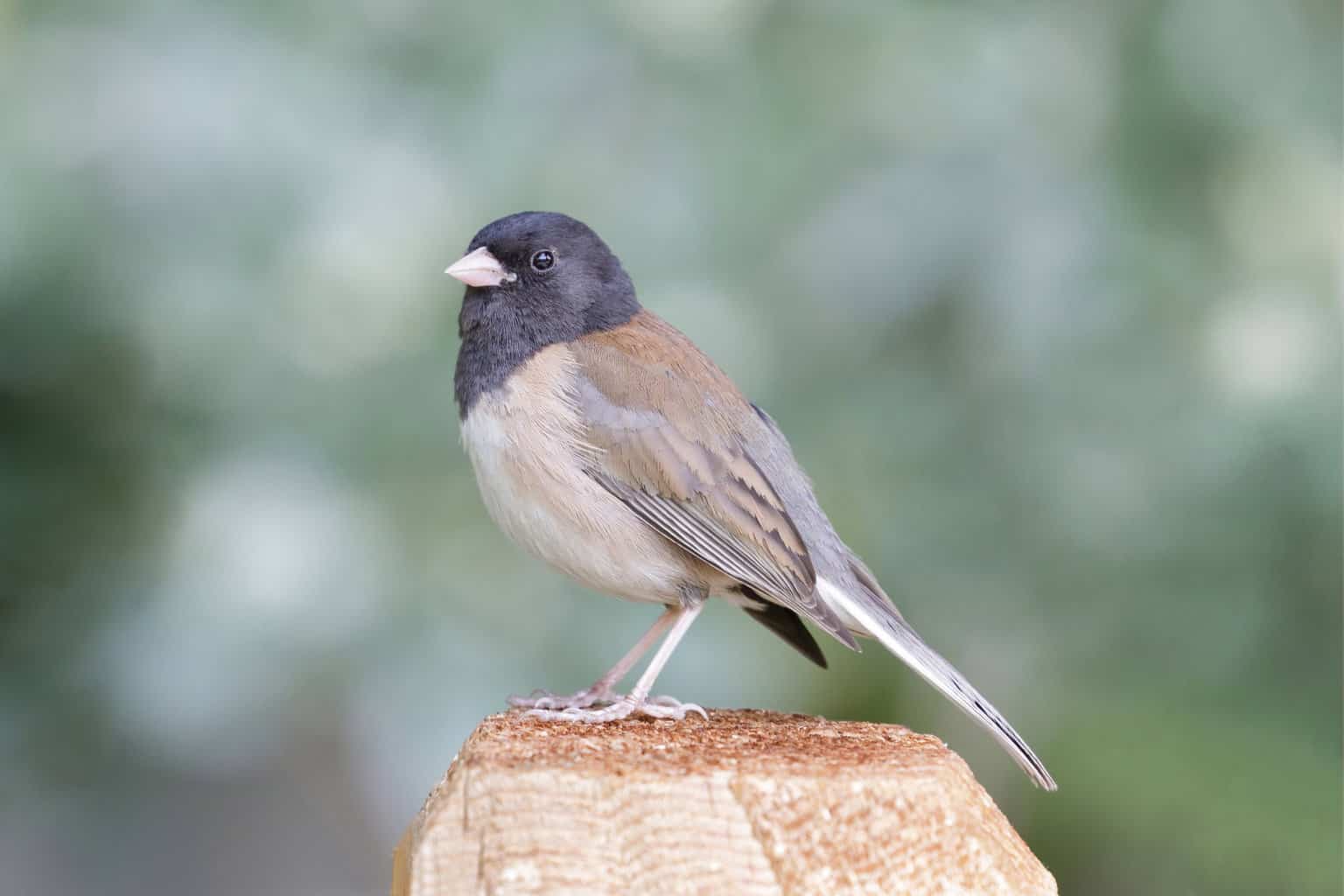
- Junco hyemalis
- Length: 5.5-6.3 inches
- Weight: 0.6-1.1 ounces
- Wingspan: 7.1-9.8 inches
While dark-eyed juncos don’t have the word “sparrow” in their name, they’re members of the Passeriformes order like the other birds on this list.
For Midwesterners, juncos are sometimes thought of as a sure sign of winter’s impending arrival. They’re not the only migratory visitor to the states, but juncos are a recognizable, familiar face.
Juncos vary in appearance across the continent, with different looks in the Rocky Mountains, American Southwest, and Pacific Northwest, among others.
The ones in Iowa are of the slate-colored variety. They are rounded birds with black eyes and lightly-colored bills. The slate gray turns to white near the belly.
Juncos are ground birds frequently seen below feeders, where they eat fallen seeds.
Spotted Towhee
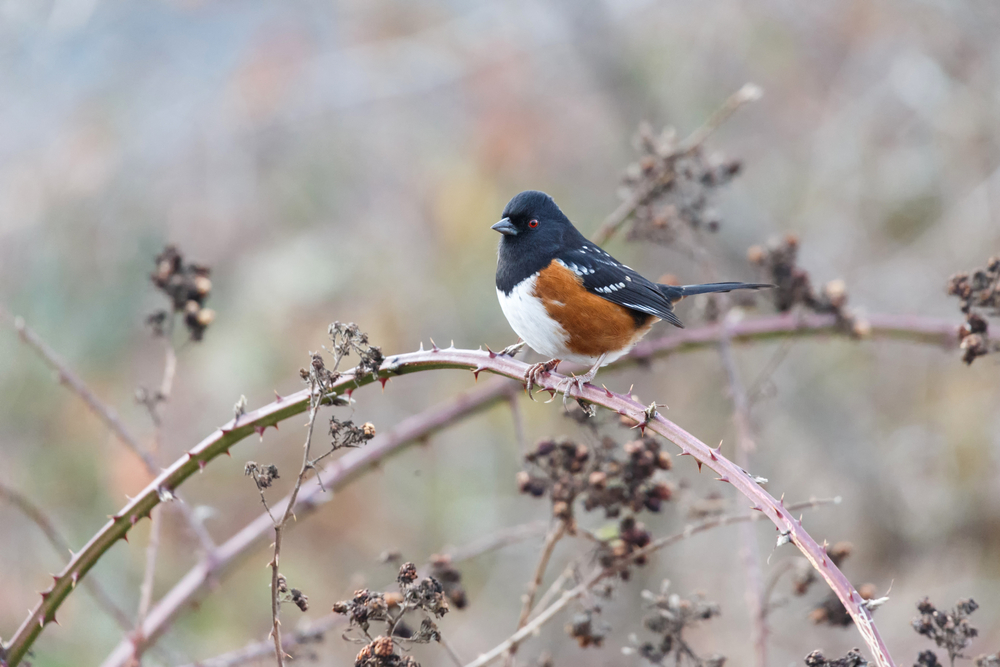
- Pipilo maculatus
- Length: 6.7-8.3 inches
- Weight: 1.2-1.7 ounces
- Wingspan: 11.0 inches
The spotted towhee is a rare Iowa sight. These are primarily birds of the American west, with a rare appearance in places like Iowa and Minnesota.
One was reported by a couple of eBird users at Oak Grove Recreation Area north of Des Moines in March of 2023, but generally, sightings are few and far between.
Males have orange sides, white bellies, and are black on the throat, head, back, wings, and tail. Their wings feature white spots, and they have red eyes.
Females look very similar, but instead of the crisp, jet black of the male, they’re brown. They still have orange sides, red eyes, white bellies, and white wing spots, so they’re still pretty identifiable.
Eastern Towhee

- Pipilo erythrophthalmus
- Length: 6.8-8.2 inches
- Weight: 1.1-1.8 ounces
- Wingspan: 7.9-11.0 inches
The more common towhee species to see in Iowa than the spotted towhee is the eastern towhee, a resident breeder in the state.
Eastern towhees have orange sides, white bellies, and black (males) or brown (females) all over everywhere else, like spotted towhees, but they don’t have the glaring red eyes that spotted towhees do. While they do have white markings on the wings, they’re not little spots like on spotted towhees.
In addition to their color and pattern differences from the other sparrows on this list, their size also stands out. Both towhee species are just a little bit smaller than a robin, in addition to their color similarities to the Robin.
Towhees are commonly seen in the ground, but you may also see one or hear one calling from inside trees or bushes.

